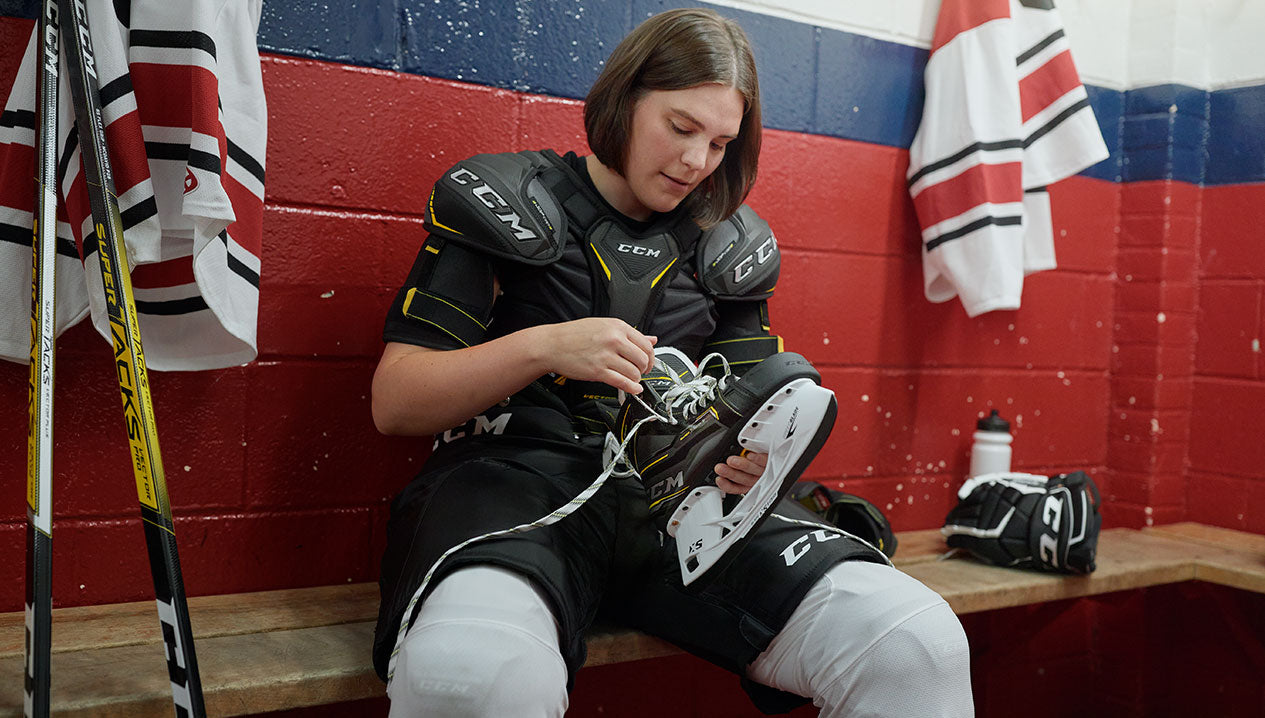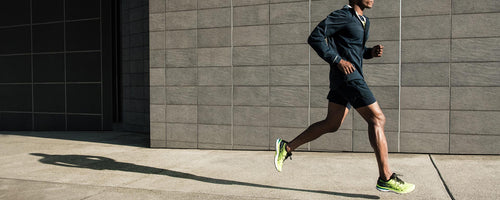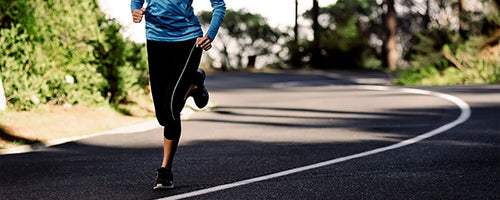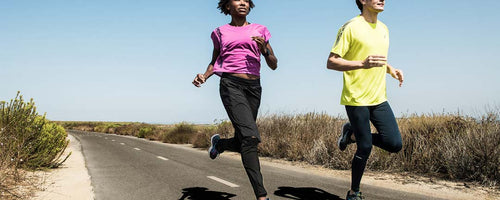How To Choose the Right Running Shoe

The techs and trends in the running shoe industry have improved and changed over the years. Today, runners have a choice of shoes in an array of wild colour trends and patterns with technical features that are lightweight, breathable, and are designed to improve your ability and comfort when hitting the pavement or treadmill.
To get the perfect shoe for you, there will be several factors to consider :
- Foot Strike
- Stack & Heel-Toe Drop
- Cushioning
- Proper Fit
- Age & Condition of Shoe
What is foot strike and why is it important?
A foot strike is how your foot strikes or hits the ground with each step you take when running. Your foot encounters force up to 2X times your body weight when taking a step walking, and up to 5X times your body weight when you are running, so support is crucial to prevent injuries to your ankles, knees, hips and back.
To run effectively, you want to have your feet hit the ground as close to your body as possible by shortening your stride and increasing your cadence, which is the rhythm of your running - short strides that result in a cadence of 180 steps per minute or higher is ideal for efficiency.
It is important to understand how your foot strikes the ground; once this has been established, you can find a shoe that will provide ultimate support and align your body to reduce the amount of stress and shock created from each step. There are 3 typical foot strike styles:
Mid-Foot Strike
- The goal for runners to run effectively and safely is to develop a technique known as “Mid-foot” running, where the whole foot is put to the ground as quickly and as efficiently as possible.
- Your heel should touch the ground briefly, however, it should not carry a large weight load; most of your weight should be directly about your mid-foot.
- It is important to concentrate on your posture: you want to keep your body upright, keeping your airway free for a consistent breathing pattern. A slight lean forward guides you into the next stride, and a slight knee bend helps reduce the shock your body will encounter when your foot strikes the ground.
Asics Rear-foot and Forefoot Gel Cushioning System technology diminish shock during impact and toe-off phases, as it allows movement in multiple planes as the foot transitions through the gait cycle.
Heel Strike
- Many people are Heel Strike runners; this is when your heel first hits the ground then moves forward to the mid-foot. If your running style is a heel striker, you are landing heavily on your heels which can cause tension and stress on your body, heel pain and shin splints.
- Many, but not all, heel strikers over-stride which can cause possible musculoskeletal stress and inefficiency, making you work much harder to run at the same speed.
Saucony offers their Full-Length Pro Grid technology in shoes to absorb impact, disperse shock and provide a seamless transition from heel through forefoot.
Forefoot Strike
-
If you are a Forefoot strike runner the initial contact is on the ball of the foot (behind the toes), followed by the dropping of the heel to make a smoother landing. This technique uses more of the calf muscles and is closest to minimalist running.
Stack and Heel-Toe Drop
- Stack Height refers to how much material is between the bottom of your foot and the ground. A shoe with higher stack height has little to no bend in the outsole to deliver more stability and allow for superior shock absorption.
- The Heel Drop is the difference in measurement between the heel height and the forefoot height. A “zero drop” shoe would have the heel and ball of the forefoot at exactly the same height off the ground. A drop of 12mm would mean that the heel sits 12 mm higher off the ground than the forefoot.
Heel Drop on the shoe minus the Toe Drop on the shoe equals the stack height:
| RUNNING SHOE STYLE | STACK HEIGHT |
|
Traditional Shoe |
12 - 15 mm heel-toe drop |
|
Moderate/Minimalist Shoe |
4 - 10 mm heel-toe drop |
|
Zero Drop Shoe |
|
When you are properly fit, a high stack does not make your balance tippy – it is only if your shoe is too large which allows your foot to shift from side to side that your balance could be unstable.
Cushioning
Don’t relate the word ‘cushioning’ as a measure of how soft a shoe is. Indeed, ‘cushioning’ refers to how the shoe provides shock absorption.
Maximalist shoes are the trend where the biomechanics of the running shoe are designed for extra cushioning to help decrease leg fatigue and ensure shorter recovery time over long distance runs. Footwear cushioning can be minimum, moderate or maximum and will vary not only between manufacturers, but also in regard to whether the shoe is designed for racing, performance or trail. Your body frame size will also affect which level of cushioning you need, not only to provide the support your particular foot needs, but to also accommodate the impact from your body weight.
FluidRide by Asics is a technology in shoes that provide the ultimate combination of bounce back and cushioning properties, with reduced weight and exceptional durability.
Proper Fit
For optimal foot and body alignment, you want your foot into the ideal “neutral” position, where there is a natural and even pressure throughout the sequence of the impact, roll through and push off. Very few runners have a perfectly neutral position, and require some kind of support to align the foot, and therefore the whole body, into this desired position.
Pronation is when the foot continues to roll inward towards the arch when it should be pushing off during the gait cycle. Knock knees and flat feet can contribute to over-pronation, which can result in knee and shin pain.
Supination refers to an insufficient inward roll of the foot and places extra stress on the outside of the foot. This can result in Iliotibial band syndrome, Achilles tendinitis and plantar fasciitis – all very painful and chronic conditions.
When you are trying on shoes in-store make sure you bring any custom orthotics or insoles with you – it is critical that the insole is fit to the shoe when you are trying them on, as a custom-made orthotic especially can change the whole fit of the shoe. Some athletic footwear styles are very low volume, meaning that if you have a ‘fuller’ and rounder foot, adding your orthotic will make your foot sit higher in the shoe, adding considerable bulk or volume, making the shoe very tight.
For those who require an insole to attain a neutral foot position, Superfeet offers a low volume insole specifically for athletic footwear.
Shoe Age and Condition
Another consideration that will affect the performance of your shoes is their age and condition. Generally, running and walking shoes last up to about 300 miles before the integrity of the foam and other supportive materials start to break down.
If you notice any aches or pains in your feet, legs, knees, hips or back, or sudden episodes of shin splints, it is a good sign that you need a new pair. Other signs include friction or blisters in unexpected places - this means your shoes have stretched and your feet are moving around too much within the shoe.
Keep in mind that pavement wears down shoes faster than a track, trail, or treadmill, therefore it is a good idea to rotate between two pairs of shoes so that you always have a pair that is broken in.
For expert advice on footwear, running, and training gear and equipment that is right for your 'game', level of experience, and budget, come see us at your local Source for Sports footwear store near you. We Fit Your Game.
Join Source Nation to get the latest news on product launches, Source Exclusive product lines, tips and tricks for parents and players, and more!



